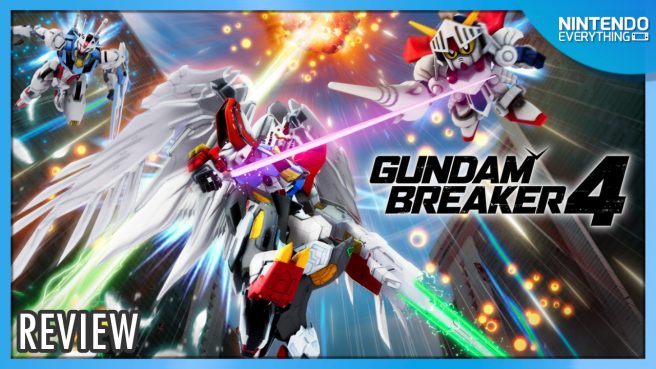[Review] Gundam Breaker 4
System: Switch
Release date: August 29, 2024
Developer: Bandai Namco
Publisher: Bandai Namco
Although I’ve always appreciated the complex political machinations, emotionally charged character dynamics, and poignant themes of war that have defined a lot of media in the Gundam series, it’s often the designs of the Mobile Suits that have determined just how much I enjoy any one particular entry. If, like me, you’ve ever wanted to make your own Mobile Suit, or thought that one might look just a little better if a few tweaks were made, then Gundam Breaker 4 is the game you’ve been waiting for. Even if you’re unfamiliar with the franchise, the depth of customization on offer makes this worth looking into if you’re in the market for something that will let you test the limits of your creativity.
Gundam Breaker 4 takes place in the virtual world GUNPLA Battle Blaze: Beyond Borders (GB4 for short) that is finally entering a beta test. You are a new player to the game who establishes a clan with literally the first people you come across, and your main focus for much of the narrative is just on enjoying yourself, by participating in missions and competing against other clans for recognition, although you’ll find yourself drawn into a wider conflict as you continue to play and become more familiar with the world. The story unfolds mostly between missions in the lobby in cutscenes with partially animated portraits of the characters accompanying their Gunpla, which make very exaggerated poses and gestures that are reminiscent of avatars from older online games despite the cutting-edge virtual reality technology.
It’s a strange juxtaposition that makes watching the story play out more engaging than it otherwise might have been, and the English voice acting was a welcome surprise, as this is not a common feature in modern Gundam titles. Japanese voiceovers are still present for those who would prefer them, but I found the quality of the English voice overs to be easily on-par with those in any Gundam anime and particularly welcome in battle, as characters will frequently make comments and it alleviated the need to try and stop to read subtitles to understand what they were saying whilst trying to focus on the combat.
As a new player to GB4 you’ll need your own Gunpla, and you’ll spend a lot of time building and upgrading it. You’ll need to choose a Head, Body, Right Arm, Left Arm, Legs, and Backpack at least to construct a Gunpla to start, and you can also select two melee and two ranged weapons of various types, from swords and machine guns to beam sabers and rifles; if a Gunpla has used it in the past, it’s available for selection here. You’ll also set the EX-Skills and OP-Skills that will form the backbone of your movepool here, which will be dependent on the parts you have equipped: these are one-off moves that have a cooldown depending on combo count and short timers. You can save blueprints for later use and tinkering, and there is an extensive filtering system allowing you to more easily identify what you’re looking for.
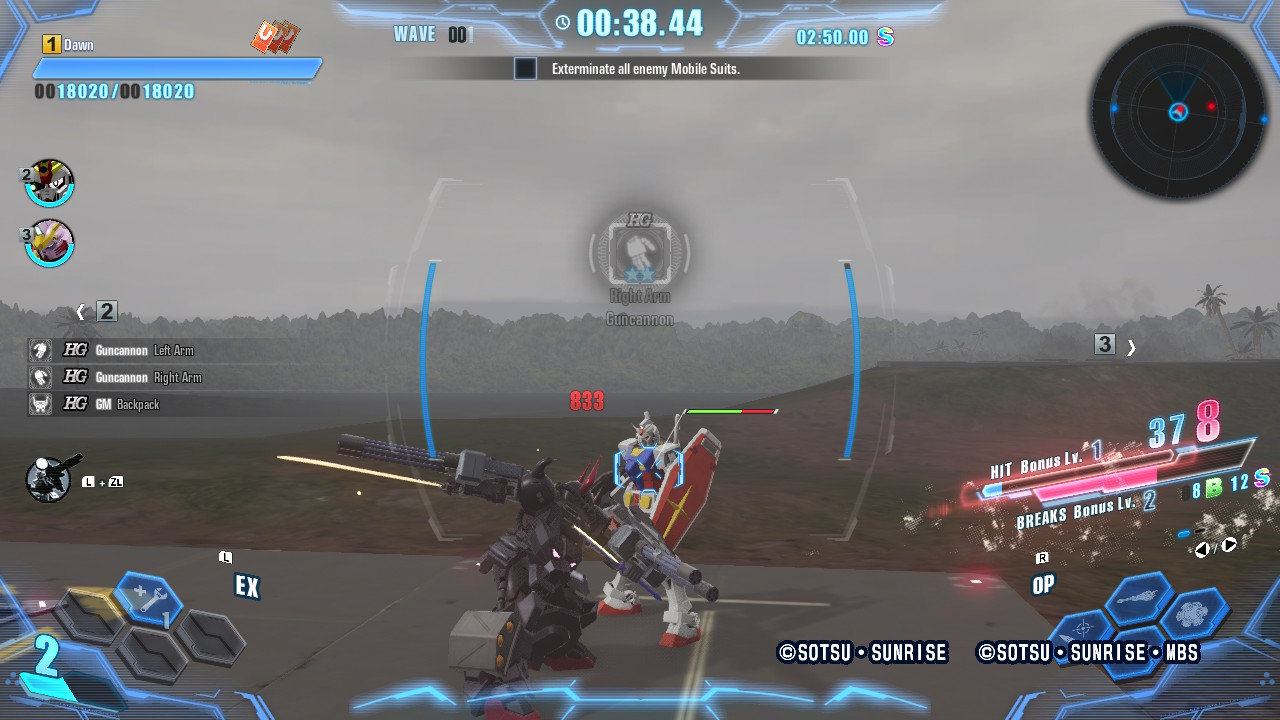
You don’t need to be a fan of (or even familiar with) Gundam to enjoy Gundam Breaker 4, but it certainly helps, as the game pulls from almost every corner of the franchise for parts to let you construct the Gunpla of your dreams…or, more likely, your nightmares, as you’ll need to unlock new parts by breaking them off of enemies and clearing missions, and for much of the game your best parts aren’t going to harmonize particularly well. It can lead to some highly amusing and truly horrifying combinations, particularly when SD parts are thrown into the mix.
Fortunately the game allows you to customize the look of your parts as well, and there is a nice amount of aesthetic design options available here, allowing you to color different areas both individually and simultaneously, as well as set decals and weathering effects. The game will also ask you if you want to transfer your existing customization over to a new part when you swap it out, which saves a significant amount of time. It might be tough to get a Gunpla you’re satisfied with, and you’ll be swapping out parts constantly throughout the game as you acquire ones of a higher rank and rarity, but you will at least be able to stand to look at your creations most of the time.
Picking the parts that are at the highest level and fit together to best suit your personal taste is, thankfully, a perfectly viable option. Specs are determined by a part’s level and rarity, and they provide mostly the same benefits regardless of the look of the part itself. So if you prefer the look of the Victory Gundam’s head, for example, and it’s of the same level and rarity as less attractive options, the game won’t punish you for choosing it over something else. If you’re not interested in taking a deep dive into the ins-and-outs of Gunpla design, Gundam Breaker 4 still presents itself as an approachable title that lets you put fashion over functionality. This is a particularly attractive option if you’ve only seen one or two series and want to play using a suit you’re familiar with, or just don’t like the look of the parts that you’ve acquired. You can also use unwanted parts to increase both the level and rarity of your favourite parts, keeping them viable for the entire game if you would prefer.
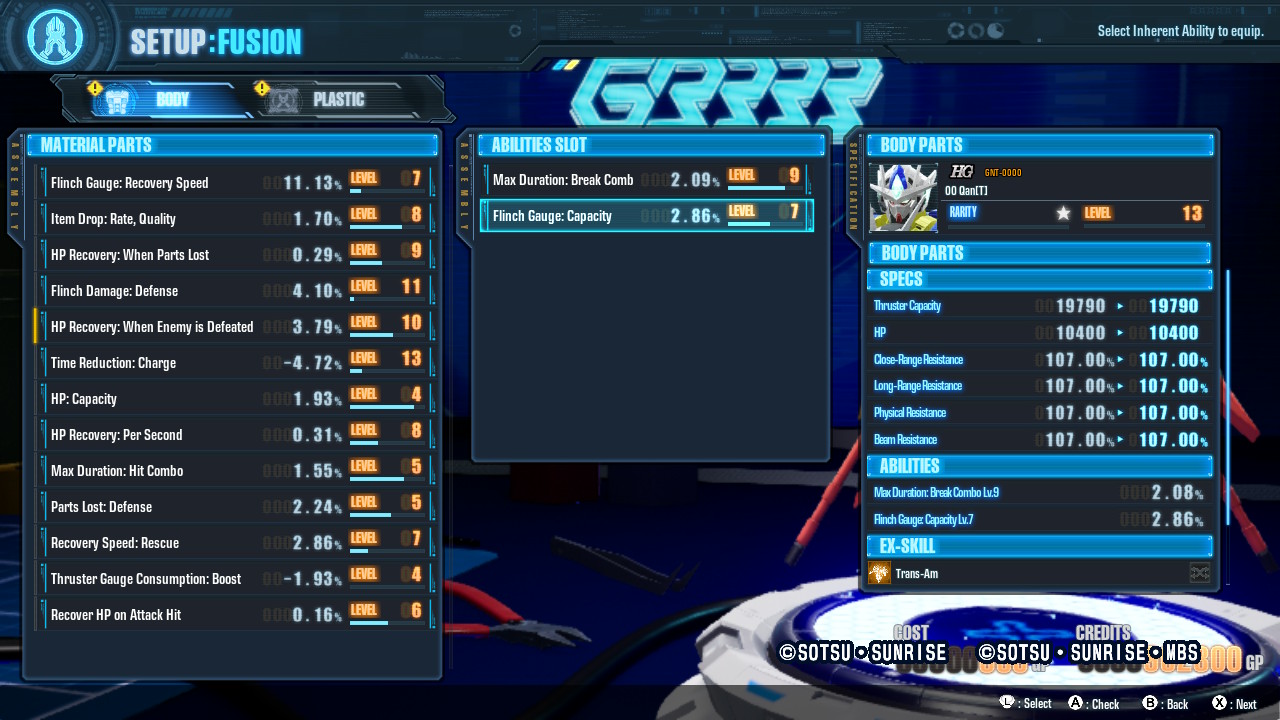
However, this is the tip of the iceberg. Constructing a Gunpla can be a very involved process if you choose as there are an almost obscene number of parameters to consider when creating the perfect fighting machine. As well as Specs, parts also have Abilities, and these vary considerably depending on what the Gunpla it originated from is best suited for. The percentage differences are often small, but they add up over time and allow for some highly specialized builds if you play into them. Some parts will also have unique Extra Abilities for additional combat skills. You can also equip eight optional Builders Parts for additional EX-Skills and OP–Skills, broadening your available movepool in combat quite substantially.
Whether you prefer surface-level aesthetic design or in-depth specialization, Gundam Breaker 4 provides more than enough to keep you occupied for hours. The problem is that the difference between these two playstyles presents quite a vast gap and there is no easy way to cross it, because the game isn’t particularly concerned with explaining itself. You’ll need to unlock the Play Guide as you progress, and it is by no means as comprehensive as it should be, covering only the basics in one or two short pages of data at most. Just how much of a difference that percentage increase or decrease in one particular stat will make in your overall build is never explained, and it’s left entirely to you to figure out what Abilities will work best with the build you’re trying to create.
Going into the deeper side of customization is quite daunting: you’re going to be staring at a lot of similar-looking parts with very little idea of how to fit them together to construct something better, and even as you progress Abilities are an almost incomprehensible jumble of tiny numbers and percentages that are ripe for exploitation, but no clear direction on how to do that. It can occasionally be quite frustrating and detrimental to the overall design process, which is where a large part of Gundam Breaker 4’s appeal lies.
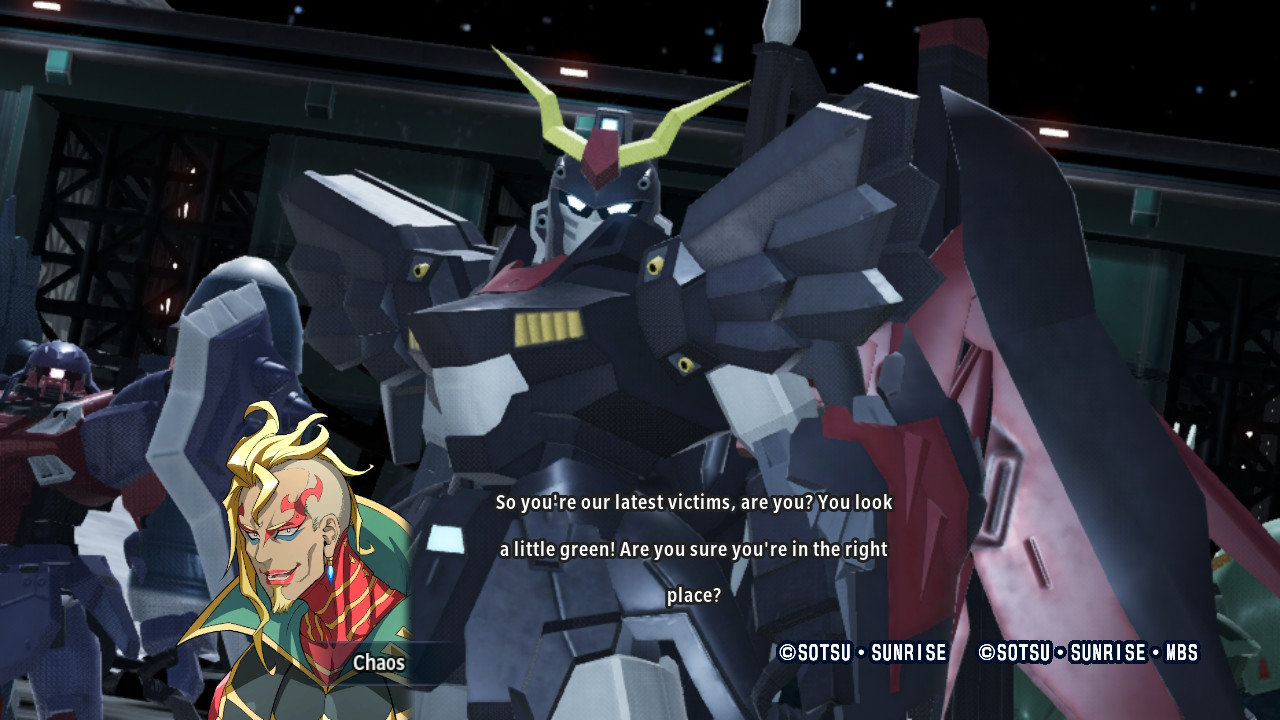
Once you’ve got your Gunpla you’ll be taking it out on Missions, which you select from the lobby. Missions are divided into Story, Quest, and Bounty Hunter varieties, although these all follow a similar structure. You and any allies you may have with you will be deposited into an area, and enemies will spawn in waves for you to take out, with the final wave featuring stronger Gundam units from across every instalment in the series that are a bit tougher to take out. After up to three waves, you’ll receive a rank based on your performance and then be transported to another stage to repeat the process. After doing this three times you’ll complete the mission, be given an overall score, then deposited back in the lobby to repeat the process.
The game will occasionally shake things up by having you defend an HLV capsule, or pit you against a giant boss (either a famous Mobile Suit or Mobile Armor from one of the many Gundam series) but most missions are short brawls that will be over within ten minutes at the most. Each stage has three initial difficulty options based on recommended parts levels, with Hardcore being substantially higher than what you’ll have available and providing a good challenge if you decide to tackle it early. As with Gunpla customization, Gundam Breaker 4 allows you to approach its content at your own pace and style: stage rewards are the same no matter which difficulty you choose, with better parts being tied to your overall performance. Breaking enemy parts, building up a combo bonus, and finishing the stage quickly, all contribute towards your overall rank, and at higher ranks you’ll acquire higher rarity parts with better specs. I found this to be a nice compromise that ensured that I didn’t fall too far behind in overall level and specs if I performed poorly, but rewarded me if I finished with an S Rank.
Combat is generally fast and frantic, with bosses being intelligent enough to block, dodge, and use their own skills, and although AI-controlled party members are largely useless on Standard and Hardcore difficulties against anything other than weaker mobs, they are at least able to keep the rank and file at bay whilst you focus on other enemies. Most Gunpla control quite smoothly, although I found that the control scheme felt far too busy and very unwieldy at times, with jump and dash being assigned to the same button and being dependent on how long you hold that button down (this is especially problematic when you need to hit airborne enemies or the top part of giant bosses) and melee attacks having both short and long presses. The lock-on can also be extremely uncooperative when enemies are clustered together, which happens often, and sometimes you can be flailing wildly whilst you reorient yourself and establish your target. When you’re racing against the timer to get the best possible score, or find yourself surrounded by stronger enemies whose attacks you’ll need to avoid, it can be quite difficult to get your unit to do exactly what you want it to. On Casual difficulty the game is perhaps a little too unengaging as well, as enemies will mill around aimlessly as they wait for you to carve them up. However, this does allow you to acquire parts to tackle higher difficulties if you’re struggling, making it a good accessibility option for those who need it.
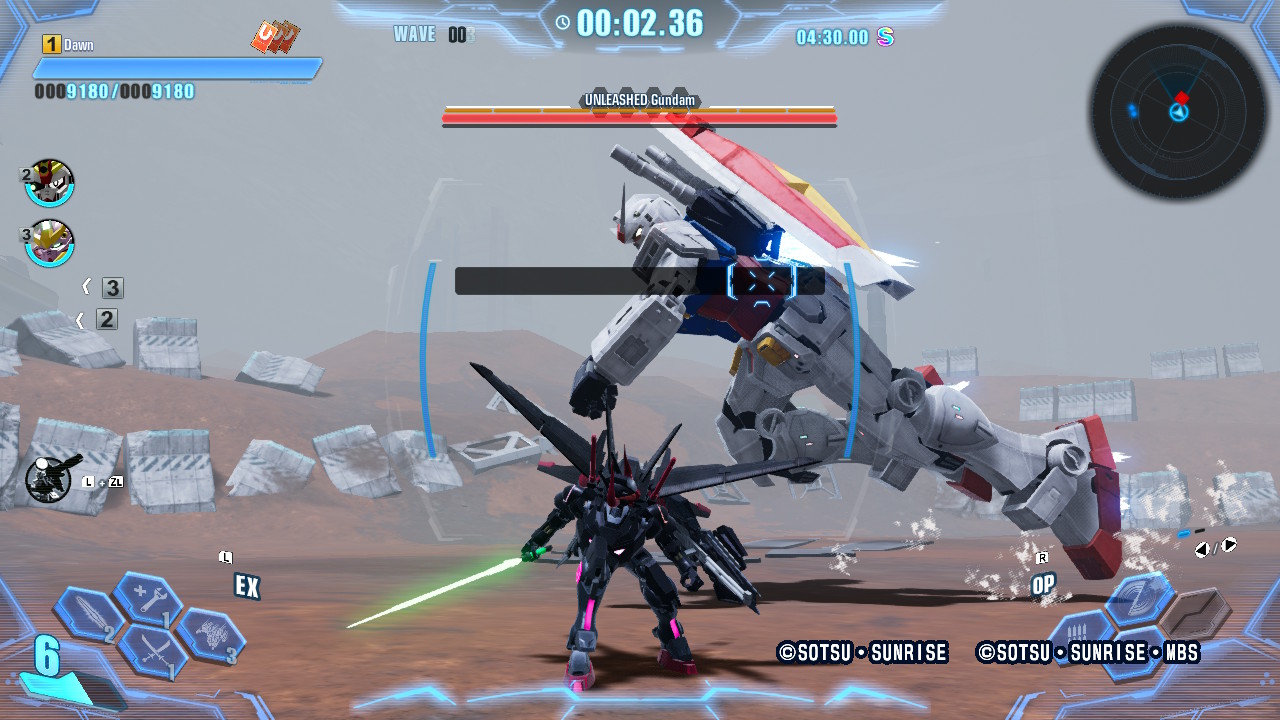
But one of the most impressive things about Gundam Breaker 4 is just how good it all looks on Switch. Of course, both performance and visuals have taken a hit when compared to other platforms, with the game targeting 30fps on Switch, but the difference is not as detrimental as I was expecting. The various environments you’ll be deposited into during missions are featureless, low resolution, and do nothing to reference any series to a noteworthy degree. However the focus of the game is the Gunpla, and if you put the time and effort into customizing the paint, or adding weather effects and decals, you’re going to see these things if the camera zooms in on your unit, even during battle. But it’s worth noting that certain patterns and textures can at times look more messy than intended, particularly in handheld mode, where the smaller screen does the visual detail no particular favors and can make things look quite flat.
As expected, things can blur a little in the heat of combat, but the game performs far better than it feels that it should. There are notable frame drops if your unit is sent flying in combat in particular, and loading times between stages in missions can become obnoxious over extended play sessions as they typically last several seconds. But overall I was impressed by just how well the game runs, considering the level of detail and amount of action typically going on during combat.
The Verdict

Gundam Breaker 4 does an excellent job at drawing from the strengths of its IP without relying on it to the extent that it alienates those who aren’t familiar with it. It’s a game you can pick up and play for a few minutes or a few hours, and it never pushes you to get any more involved with its more intricate gameplay systems than you feel comfortable with. Despite the weaker performance when compared to versions on other systems, it’s an easy recommendation to make on Switch.
